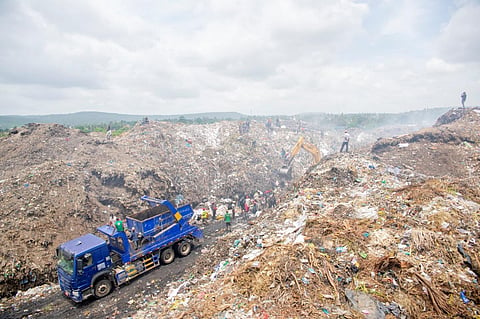Dar-es-Salaam’s waste management needs a complete revamp
Dar-es-Salaam is considered the economic capital of Tanzania as it is the third fastest growing city in Africa and the ninth fastest in the world. The city is facing a huge burden of waste disposal which needs a complete overhaul.
The region, with an area of 1,493 square kilometres and a population of 7.4 million, comprises municipalities of Kigamboni, Kindondoni, Temeke and Ubungo and Dar-es-Salaam city council.
Dar-es-Salaam city’s urban population is growing rapidly and the city is witnessing increasing waste generation. Additionally, nearly 70 per cent of the city’s population is residing in informal settlements, which will eventually increase demand for urban services, including waste management.
Waste generation in Dar-es-Salaam has tripled in the past 16 years. The city generates nearly 4,500 tonnes of municipal solid waste per day, out of which, only 50-70 per cent gets collected by the city.
All the waste collected eventually ends up in the Pugu dumpsite located nearly 35 km from the city centre. Collection service schedules in the city are not regular and inefficient due to an insufficient number of collection vehicles, traffic congestions and under-planned infrastructure.
Informal sector collecting and sorting waste at Pugu dumpsite. Photo: Serengeti bytes
A major fraction of the waste generated is not formally collected; it is buried, burned, or illegally dumped. Dumping of waste at the Pugu dumpsite is currently the predominant method of waste disposal in the city.
The dumpsite receives about 600-700 tonnes per day (TPD) from the Dar-es-Salaam city council, 200-300 TPD from Ubungo, 100-200 from Temeke and 400-500 TPD from Kinondoni. A fraction of waste disposed of at the Pugu dumpsite comes from Kigamboni.
It is important to notice that the Pugu dumpsite was initially planned to be constructed as an engineered landfill site with all the pollution control mechanisms in place. However, the plans failed at the construction stage due to fund constraints and later, the site became an open dumping site due to unscientific and haphazard operations.
The site is currently operated as an open dumpsite without any fencing, barrier layers, soil cover, leachate and gas collection or treatment systems. In addition, the site has steep slopes, no access roads, smoulders, puddles of leachate and other associated environmental hazards.
Tanzania is a tropical country with two rainy seasons — a shorter and a longer one in November-December and in March-May, respectively.
This can mean that sometimes proper waste disposal stops for extended periods (for example, weeks). Operating the equipment on an unstable dump is dangerous and can lead to accidents.
The city imposes a gate fee for disposing of waste at the Pugu dumpsite, according to officials of the Dar-es-Salaam city council. The gate fee for every truck of household waste entering the site is 1,500 Tanzanian shilling (TZS) per tonne and 15,000 TZS/tonne for industrial non-hazardous waste.
There are no formal recycling and composting activities in the city. Recycling of dry recyclables is mainly done by the informal sector at the site. Nearly 900-1,000 people work at the Pugu dumpsite informally and there is no data available on the rest of the informal waste pickers within the city.
History of waste dumping sites in Dar-es-Salaam, Tanzania
|
Name of dumpsite/landfill |
Years of operation |
Life span In years |
Location characteristics |
|
Mchikichini dumpsite |
1935-1954 |
19 |
Open land in planned residential area |
|
Magomeni dumpsite |
1954-1964 |
10 |
Open land close to Jangwani river valley |
|
Tabata dumpsite |
1964-1991 |
27 |
Open land within industrial and residential area close to Msimbazi river valley |
|
Kunduchi dumpsite |
1991-1992 |
2 |
Open land within unplanned residential area area close to Indian Ocean |
|
Vingunguti dumpsite |
1992-2001 |
8 |
Open land within unplanned residential area area close to Msimbazi river valley |
|
Mtoni dumpsite |
2001-2007 |
6 |
Degraded land within unplanned residential area close to Indian ocean |
|
Kigogo dumpsite |
2007-2009 |
2 |
Degraded land within unplanned residential area close to Msimbazi river valley |
|
Pugu dumpsite |
2009- present |
15 |
Open land within unplanned residential area |
Source: Michael Yhdego (2017) Environmental Resources Consultancy, Pugu Kinyamwezi site EIA study
The waste management ecosystem in the city needs a complete overhaul. One of the major challenges is to improve the collection coverage, which is currently 60 per cent. The others are diverting the generated waste from reaching the dumpsite and establishing resource recovery within the city.
The city needs to invest in improving the collection coverage, promoting source separation, developing infrastructure to handle source-separated waste and establishing treatment plants for biodegradables and recyclables.
However, as an interim measure, it is critical to managing the dumpsite scientifically. Appropriate mechanisms ensuring waste compaction and daily soil cover are extremely important to minimise the fire hazards at the site.
Also, the site can be converted into an integrated solid waste management facility by adopting mechanisms for sorting biodegradables and dry recyclables. This can be done by engaging with and organising the waste pickers working at the site.
In addition, wet biodegradable waste can be treated to produce compost, which could be used as an alternative cover material for the dumpsite or as a soil enricher after quality testing. The sorted dry recyclables can be channelised to the recycling facilities, thereby minimising the burden on the dumpsite.


